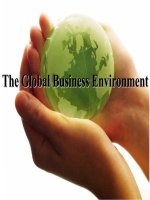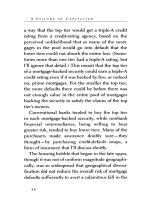Global business environment
Bạn đang xem bản rút gọn của tài liệu. Xem và tải ngay bản đầy đủ của tài liệu tại đây (241.42 KB, 27 trang )
1- 1
Principles of Economics Spring 2014
Global Business
Environment
1
1- 2
Global Business Environment
The global business environment
– the environment in different sovereign countries,
with factors exogenous to the home environment
of the organization, influencing decision making
on resource use and capabilities.
The external environment vs. the internal
environment
– The external environment includes the social,
political, economic, regulatory, tax, cultural,
legal, and technological environments.
1- 3
Global Business Environment
To function effectively and efficiently, firms
operating internationally must understand the
social environment of the host country they
are operating in.
1- 4
Global Business Environment
Forces outside the firm’s traditional
boundaries are increasingly important in
determining the firm’s success.
These forces in “the environment of business”
differ among nations and over time
requiring modifications in strategies and
management practices.
4
1- 5
Four Sets of Forces
1. Social Forces:
– Subject of ethical codes and CSR strategies
– A major force underlying the CSR challenges in
international business is the difference in culture
among countries.
– Hofstede and Bond (1988) conclude that each
country’s culture can be best examined in accordance
with five dimensions: individualism/collectivism,
uncertainty avoidance, power distance,
masculinity/femininity, and long-term versus short-
term orientation.
5
1- 6
Four Sets of Forces
– In China, the pervasive importance of guanxi
demonstrates the benefits that MNEs derive from
developing ongoing and long-term exchanges of
favors that link individuals, as well as the
organizations in which they work.
– Personal relationships that involve an ongoing
exchange of favors may be criticized as petty
corruption that can pervade all types of business
transactions, both between firms and also with
government employees.
– While some of this bribery can simply expedite
decisions and actions, other situations may involve
a distortion of business outcomes.
6
1- 7
Four Sets of Forces
2. Technological Forces:
– The technological environment comprises factors
related to the materials and machines used in
manufacturing goods and services.
– Each nation, and each region within each nation,
has its own unique innovation system that forms a
key component of the environment of business.
– The reality rests to a large degree on culture, social
capital, education, and entrepreneurship.
– Biotech, Global warming, green energy, etc.
7
1- 8
Four Sets of Forces
3. Economic Forces:
– Economic forces differ among nations and
continually change over time.
– Economic factors exert huge impacts on firms
working in an international business environment.
– The economic environment relates to all the factors
that contribute to a country's attractiveness for
foreign businesses, such as monetary systems and
macroeconomic variables (growth rates,
unemployment and inflation rates, and foreign
exchange rates)
8
1- 9
Four Sets of Forces
4. Political and Governmental Forces:
– Political and governmental forces are related to
each of social, technological, and economic forces.
– These forces play a key role in the building of social
capital, the fostering of entrepreneurship, and the
facilitation of immigration.
– The political environment in a country influences
the legislation and government rules and regulations
under which a foreign firm operates.
9
1- 10
Post Global Financial Crisis Int’l
Business Strategy
Orr (2010)
Did the international strategies of global
business change in response to the GFC?
– 1. global businesses based in home countries which
experienced a deep recession
– 2. global businesses based in home countries which
did experience recession, but had strong financial
and capital markets leading to rapid recovery
– 3. global businesses based in home countries which
did not experience recession
10
1- 11
Post Global Financial Crisis Int’l
Business Strategy
Economic theory predicts a reduction in
internalization when the cost of capital is higher,
as experienced in the recent global financial
crisis (Ricardo 1963).
– This prediction has been supported by a global
reduction in foreign direct investment (FDI) of
30 % (UNCTAD, 2009).
11
1- 12
Post Global Financial Crisis Int’l
Business Strategy
Empirical evidence from the 1991-1992 world
recession identified reduction of internal costs as
a post-recession global business response.
– This was primarily achieved by flattening hierarchies
and outsourcing operations to lower-cost countries.
– Outsourcing has became much more attractive as low
labor cost countries develop their technical and
resource capacity to provide activities such as IT,
accounting, basic manufacturing and call center work
in response to demands from international businesses
based in developed countries (Sharpe, 1997).
12
1- 13
Post Global Financial Crisis Int’l
Business Strategy
– This was primarily achieved by flattening
hierarchies and outsourcing operations to lower-cost
countries.
– Outsourcing has became much more attractive as
low labor cost countries develop their technical and
resource capacity to provide activities such as IT,
accounting, basic manufacturing and call center
work in response to demands from international
businesses based in developed countries (Sharpe,
1997).
13
1- 14
Post Global Financial Crisis Int’l
Business Strategy
Focusing on core activities also has the effect of
directing an organization’s strategies away from
diversification.
– Internalization is a form of geographical
diversification.
– Even companies producing global products and
services (such as airlines and book publishers) found
that the level of organizational structure variation
between that of the home country and subsidiaries in
other countries necessary to sustain the business was
a large barrier to internalization for companies based
in home countries recently recovered from a
recession (Birkinshaw and Morrison, 1995).
14
1- 15
Post Global Financial Crisis Int’l
Business Strategy
1. Deeply entered a recession
– Iceland, Japan
Iceland: banking industry
– FDI has been substantial the objectives of
increasing economies of scale to globally
competitive levels and gaining access to foreign
markets (Óladóttir, 2009).
– This internalization behavior ended when Iceland
entered a depression (OECD Economic Surveys,
2009), precipitated by the collapse of the banking
industry (Country Monitor, 2009a).
15
1- 16
Post Global Financial Crisis Int’l
Business Strategy
1. Deeply entered a recession (cont’)
Japan: Toyota
– Profitability was badly affected by the GFC a fall
from record profits to record losses over 12 months
– Toyota's Japanese operations were dependent on its
export market and attractive exchange rates.
– In reaction to global currency fluctuations, the lower
value of currencies in countries such as the US, and
the possible mercantile behaviors of the governments
of some of its host country markets, it has decided to
increase the percentage of local production in the
products it sells in its foreign markets.
16
1- 17
Post Global Financial Crisis Int’l
Business Strategy
1. Deeply entered a recession (cont’)
US: Exxon Mobil
– In response to the GFC, Exxon Mobil reduced costs
by outsourcing IT operations to lower-cost Indian IT
service providers (EmergingMarketsNOW 2009a).
– It also moved into related diversification such as R&D
into biofuels.
– As a result of the demand for energy in industries
based in countries not in recession, Exxon Mobil has
been able to maintain some internalization, but only
using funds from international markets in the same
regions.
17
1- 18
Post Global Financial Crisis Int’l
Business Strategy
Implications
– Porter's theory of national competitive advantage: the
increased cost of capital in foreign markets (a
supporting industry) is an effective barrier to
internalization
– Exchange rate theory: weak domestic exchange rates
for countries still in significant recession will increase
the cost of internalization.
– Political theory: home country governments’
initiatives will be focused on domestic business
development, reducing the effective home country
government’s support for internationalization.
18
1- 19
Post Global Financial Crisis Int’l
Business Strategy
2. Briefly entered a recession
– Australia, Singapore
– As a result of the relative stability of their home
country environment, exchange rate instability and
the reduction in attractiveness of foreign markets,
companies with these home countries reduced their
rate of internalization.
In these countries, government intervention has made
the home country markets more attractive and has
caused international businesses to switch some of their
development investment to their home country market
rather than to foreign markets.
19
1- 20
Post Global Financial Crisis Int’l
Business Strategy
2. Briefly entered a recession (cont’)
– International businesses with home markets such as
Australia, which are located in geographical regions
experiencing continued high economic growth, still
tended to internationalize into high economic
growth rate foreign markets.
Implications
– Porter's Five Forces theory: a return to
internationalization activities in higher economic
growth rate host countries because the threat of new
entrants (from other developed countries) is
reduced.
20
1- 21
Post Global Financial Crisis Int’l
Business Strategy
2. Briefly entered a recession (cont’)
– Exchange rate theory : although the initial
internationalization investment outlay may be
higher, interest rates in those home countries were
generally at an all-time low, and the higher foreign
market currency exchange rates, resulting from the
high levels of economic growth, would result in
greater profits to repatriate to the home country.
21
1- 22
Post Global Financial Crisis Int’l
Business Strategy
3. Never entered a recession
– Maintained strong levels of internalization activity
– China, India
China: Sinopec
– Sinopec is experiencing a profit increase in 2009 off
50% (Country Monitor 2009c)
– Whilst Sinopec is investing heavily in establishing
production facilities and in exploration in China, it
is also investing heavily in acquisitions outside of
China.
22
1- 23
Post Global Financial Crisis Int’l
Business Strategy
China: Sinopec (cont’)
– To fund its acquisitions, it formed partnerships with
companies such as Kuwait Petroleum Corporation
and released bonds into the Chinese bond market
(Company Monitor 2009).
– Sinopec's international strategy is to meet
increasing domestic demands through expansion of
its direct access to oil and gas assets (King 2009).
23
1- 24
Post Global Financial Crisis Int’l
Business Strategy
India: Tata
– Tata Motors took advantage of the weakness of
competitors whose home country markets were in
recession and acquired the UK Jaguar Land Rover
company.
– a net profit of US$300 million and an increase in
revenue of 25%, indicating that business activity
remains strong in its home country market (Sheth et
al. 2009).
– It has also been increasing its internationalization in
those Asian countries which have not experienced a
deep recession (EmergingMarketsNOW 2009b).
24
1- 25
Post Global Financial Crisis Int’l
Business Strategy
Implications
– Exchange rate theory: The weakening of the exchange
rates in countries which have experienced a recession,
relative to the home country currency of the
international business, makes companies in those
home country markets attractive acquisition targets.
– Dunning's eclectic theory: local conditions are
attractive due to the reduced resources and capital
available to local companies with which to compete
against an international business acquiring local
businesses .
– Porter's Five Forces and national competitive
advantage theories do not predict this international
strategy behavior of acquisition of companies in weak
foreign markets
25









